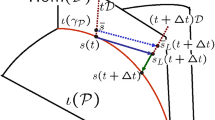Abstract
On the probability simplex, we can consider the standard information geometric structure with the e- and m-affine connections mutually dual with respect to the Fisher metric. The geometry naturally defines submanifolds simultaneously autoparallel for the both affine connections, which we call doubly autoparallel submanifolds. In this note we discuss their several interesting common properties. Further, we algebraically characterize doubly autoparallel submanifolds on the probability simplex and give their classification.
Access this chapter
Tax calculation will be finalised at checkout
Purchases are for personal use only
Similar content being viewed by others
Notes
- 1.
These cases contradict the fact that \(e \in V_0\).
- 2.
These cases correspond to choosing smaller q or r in the setup.
References
Amari, S.-I., Nagaoka, H.: Methods of Information Geometry. Tanslations of mathematical monographs, vol. 191, American Mathematical Society and Oxford University Press (2000)
Ohara, A.: Information Geometric Analysis of an Interior Point Method for Semidefinite Programming. In: Barndorf-Nielsen, O., Jensen, V. (eds.) Proceedings of Geometry in Present Day Science, pp. 49–74. World Scientific (1999)
Ohara, A.: Geodesics for dual connections and means on symmetric cones. Integral Equ. Oper. Theory 50, 537–548 (2004)
Ohara, A., Wada, T.: Information geometry of q-gaussian densities and behaviours of solutions to related diffusion equations. J. Phys. A: Math. Theor. 43, 035002 (18pp.) (2010)
Uohashi, K., Ohara, A.: Jordan algebras and dual affine connections on symmetric cones. Positivity 8(4), 369–378 (2004)
Ikeda, S., Tanaka, T., Amari, S.-I.: Stochastic reasoning, free energy, and information geometry. Neural Comput. 16, 1779–1810 (2004)
Matúš, F., Ay, N.: On maximization of the information divergence from an exponential family. In: Proceedings of WUPES’03, pp. 199–204 (2003)
Montúfar, G.F.: Mixture decompositions of exponential families using a decomposition of their sample spaces. Kybernetika 49(1), 23–39 (2013)
Nagaoka, H.: Information-geometrical characterization of statistical models which are statistically equivalent to probability simplex (2017). arXiv:1701.07736v2
Ay, N., Jost, J., Lê, H.V., Schwanchhöfer, L.: Information Geometry. Springer, Berlin (2017)
Kobayashi, S., Nomizu, K.: Foundations of Differential Geometry II. Interscience Publishers (1969)
Ohara, A.: Geometry of distributions associated with Tsallis statistics and properties of relative entropy minimization. Phys. Lett. A 370, 184–193 (2007)
Acknowledgements
The authors are grateful to a reviewer who has pointed out the Ref. [10] and given comments to improve the original manuscript. A. O. is partially supported by JSPS Grant-in-Aid (C) 15K04997 and H. I. is partially supported by JST PRESTO and JSPS Grant-in Aid (C) 16K05174.
Author information
Authors and Affiliations
Corresponding author
Editor information
Editors and Affiliations
A Complements for Proposition 1
A Complements for Proposition 1
We shortly summarize basic notions of the relation between submanifolds and affine connections and give an outline of the proof for Proposition 1.
For an n-dimensional manifold \(\mathcal{M}\) equipped with an affine connection \(\nabla \), we say that a submanifold \(\mathcal{N}\) is autoparallel with respect to \(\nabla \) when it holds that \(\nabla _X Y \in \mathcal{X}(\mathcal{N})\) for arbitrary \(X, Y \in \mathcal{X}(\mathcal{N})\). Since \(\nabla ^{(\alpha )}\) is nothing but an affine combination of \(\nabla =\nabla ^{(1)}\) and \(\nabla ^*=\nabla ^{(-1)}\), we see that \(\mathcal{N}\) is actually DA if \(\mathcal{N}\) is autoparallel for arbitrary two connections \(\nabla ^{(\alpha )}\) and \(\nabla ^{(\alpha ')}\) with \(\alpha \not =\alpha '\). Hence, the equivalence of the statements (1), (2) and (3) is straightforward.
If every \(\nabla \)-geodesic curve passing through a point \(p \in \mathcal{N}\) that is tangent to \(\mathcal{N}\) at p lies in \(\mathcal{N}\), then \(\mathcal{N}\) is called totally geodesic at p. If \(\mathcal{N}\) is totally geodesic at every point of \(\mathcal{N}\), then we say that \(\mathcal{N}\) is a totally geodesic submanifold in \(\mathcal{M}\). When \(\nabla \) is torsion-free, a submanifold is totally geodesic if and only if it is autoparallel [11]. Since every \(\nabla ^{(\alpha )}\) is torsion-free by the assumption, the equivalence of (3) and (4) holds.
When \(\nabla \) is flat, there exists a coordinate system \((x^1, \ldots , x^n )\) of \(\mathcal{M}\) satisfying \(\nabla _{\partial /\partial x^i} \partial /\partial x^j=0\) for all i, j, which we call a \(\nabla \)-affine coordinate system. It is well known ([1, Theorem 1.1], for example) that a submanifold is \(\nabla \)-autoparallel if and only if it is expressed as an affine subspace with respect to \(\nabla \)-affine coordinate system. Then the equivalence of (1) and (5) immediately follows.
For the final statement a proof is given in [12] when \(\mathcal{M}\) is the probability simplex. Since the proof for this general case is similar, it is omitted.
Rights and permissions
Copyright information
© 2018 Springer Nature Switzerland AG
About this paper
Cite this paper
Ohara, A., Ishi, H. (2018). Doubly Autoparallel Structure on the Probability Simplex. In: Ay, N., Gibilisco, P., Matúš, F. (eds) Information Geometry and Its Applications . IGAIA IV 2016. Springer Proceedings in Mathematics & Statistics, vol 252. Springer, Cham. https://doi.org/10.1007/978-3-319-97798-0_12
Download citation
DOI: https://doi.org/10.1007/978-3-319-97798-0_12
Published:
Publisher Name: Springer, Cham
Print ISBN: 978-3-319-97797-3
Online ISBN: 978-3-319-97798-0
eBook Packages: Mathematics and StatisticsMathematics and Statistics (R0)




